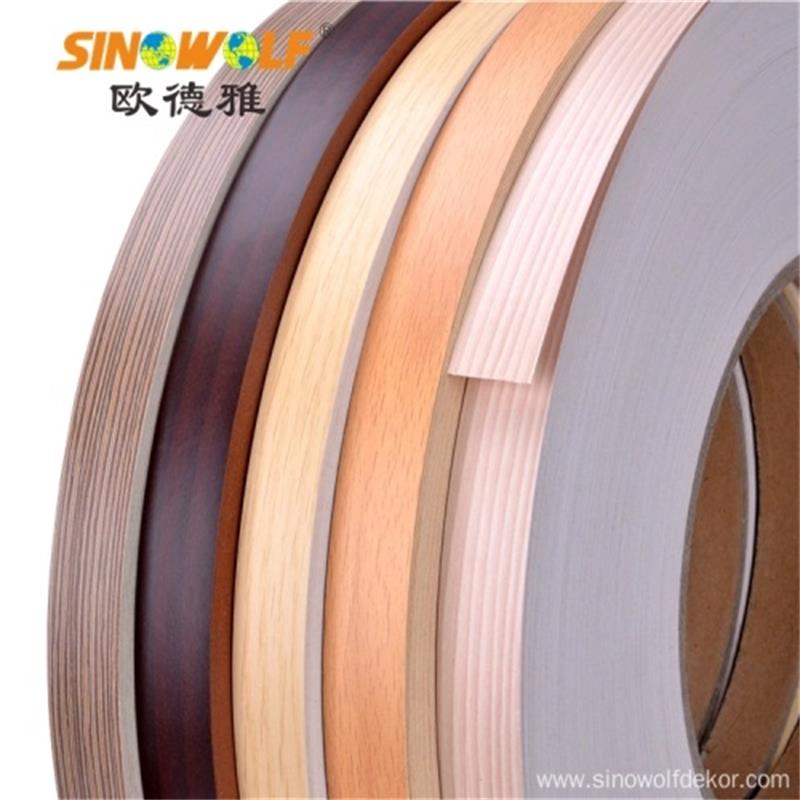What Is Edge Banding for Plywood?
Edge banding for plywood refers to the process of applying a thin strip of material—commonly melamine, PVC, or wood veneer—to the exposed edges of plywood panels. Since plywood is constructed by gluing multiple veneer layers together, its edges often reveal the layered cross-section, which can look unfinished and be prone to damage. By applying edge banding, manufacturers and DIY users enhance both the aesthetic appeal and structural protection of plywood furniture or panels.
Edge banding not only improves appearance but also increases the plywood’s resistance to moisture, mechanical wear, and impact. Today, it is widely used in the production of cabinets, office furniture, kitchen panels, and decorative interiors.
Key Features of Edge Banding for Plywood (with Professional Data)
Durability and Mechanical Strength
Edge banding significantly improves the resistance of plywood edges against chipping and impact.
PVC Edge Banding typically has a tensile strength of 40–50 MPa, ensuring it withstands daily use in high-traffic furniture applications.
Compared to unfinished plywood, properly banded panels demonstrate 20–30% higher edge impact resistance, extending service life.
Moisture and Heat Resistance
Plywood edges are vulnerable to absorbing moisture, which can lead to swelling.
Edge banding forms a protective barrier, limiting water absorption to less than 2% after 24 hours of exposure, depending on material type.
Melamine and PVC banding can also withstand temperatures up to 70–90°C, making them suitable for kitchens and bathrooms.
Aesthetic Variety
Edge banding is available in over 500 colors and patterns, including wood grain, solid shades, and metallic finishes.
Standard thicknesses range from 0.4 mm to 3 mm, allowing manufacturers to select styles that complement different plywood grades.
This design flexibility ensures seamless integration with plywood surfaces, creating a polished, premium appearance.
Cost-Effectiveness
Applying edge banding is much more economical than using solid wood edging.
On average, PVC edge banding costs 30–40% less than natural wood edging while delivering similar durability and appearance.
The process reduces waste since banding strips are produced in precise dimensions, minimizing excess trimming.
Ease of Application
Edge banding can be applied manually using a household iron (for pre-glued types) or with industrial edge banding machines.
The adhesive bond strength typically reaches 10–12 N/mm², ensuring reliable adhesion under normal usage conditions.
With manual application, a panel edge can be covered in less than 5 minutes, making it efficient for small-scale projects.
Eco-Friendly Options
Many melamine and PVC edge banding products meet E0 and E1 formaldehyde emission standards (≤0.124 mg/m³), ensuring safety for indoor use.
Some suppliers also offer edge banding made from recyclable materials, aligning with sustainable manufacturing practices.
Application Scenarios of Edge Banding on Plywood
Furniture Manufacturing
Edge banding is widely used in cabinets, wardrobes, bookshelves, and desks.
For example, in kitchen cabinets, edge banding prevents moisture absorption and enhances surface hygiene, making it easier to clean.
Interior Decoration
Wall panels, partitions, and modular furniture benefit from edge banding’s clean and professional finish.
Hotels, offices, and retail spaces often rely on banded plywood for a polished appearance.
Commercial and Office Spaces
Conference tables, workstations, and storage units often use plywood with edge banding.
The banding improves durability in high-use environments, reducing maintenance costs.
Educational and Public Institutions
In schools, libraries, and hospitals, edge banding ensures safety by covering rough plywood edges, reducing splinter risks.
PVC edge banding with a thickness of 2 mm is often chosen for high-durability requirements in public furniture.
DIY and Small-Scale Projects
Hobbyists and carpenters use Pre-Glued Edge Banding for quick fixes and upgrades.
It is ideal for home projects like custom shelves, wardrobes, and workbenches.
Maintenance of Edge Banded Plywood
Regular Cleaning
Clean with a soft cloth and mild detergent. Avoid abrasive cleaners, as they can damage the surface finish.
Melamine and PVC edge banding have a surface hardness of 3H–4H, which resists scratches but still benefits from gentle cleaning.
Temperature and Humidity Control
Avoid exposing edge banded plywood to extreme temperatures or humidity.
Prolonged exposure above 90°C may weaken the adhesive bond, while excessive humidity can lead to material warping.
Avoid Mechanical Stress
Do not apply excessive force to panel edges, as sharp impacts may loosen or chip the banding.
Furniture edges should be checked periodically for any signs of lifting or peeling.
Periodic Inspection
Inspect joints and edges every 6–12 months, especially in commercial or high-use environments.
If peeling occurs, reapply adhesive with heat or replace the damaged section.
Protective Measures
In kitchens and bathrooms, use sealants at panel joints for added moisture resistance.
Apply edge protectors for heavy-duty furniture to extend lifespan.
Conclusion
Applying edge banding to plywood is an essential step in producing durable, attractive, and cost-effective furniture or decorative panels. With superior resistance to wear, moisture, and impact, as well as an extensive range of design options, edge banding significantly enhances both the functionality and visual appeal of plywood.
Whether for furniture manufacturing, interior decoration, office spaces, or DIY projects, edge banding transforms raw plywood into a finished product that meets modern design and durability standards. With proper maintenance practices, such as cleaning, inspection, and protective measures, edge banded plywood can maintain its quality and performance for many years.
For businesses in the furniture and woodworking industries, investing in high-quality melamine or PVC edge banding ensures a professional finish that appeals to customers while optimizing production efficiency and cost savings.






